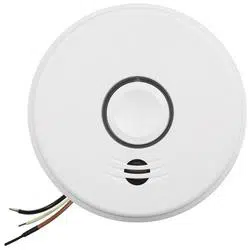Loading ...

120V AC Smoke Alarm with 10-Year Battery Backup
and Wire-Free Interconnect
Model P4010ACS-W
Architectural and Engineering
Specifications
The smoke alarm model shall be P4010ACS-W or approved equal and is
powered by a 120VAC, 60Hz source along with lithium battery backup.
The lithium batteries shall be sealed in the unit to prevent removal and/or
tampering. The unit shall incorporate a photoelectric sensor.
The smoke alarm can be installed on any standard single gang electrical
box, up to a 4”octagon junction box, following the UL/Manufacturer’s
approved placement guidelines.The electrical connection (to the alarm)
shall be made with a plug-in connector. The alarm shall incorporate
an activation switch that can be engaged with the included tool or
screwdriver to power on the alarm at startup, and deactivate the alarm at
end of alarm life.
The P4010ACS-W shall include a test button that will simulate a fire
condition and cause the unit to go into alarm. This sequence tests the
unit’s electronics to ensure proper operation.
A maximum of 24 Kidde devices can be interconnected in a multiple
station arrangement. The interconnect system must not exceed the NFPA
(National Fire Protection Association) limit of 18 initiating devices, of
which 12 can be smoke alarms.
The unit shall have audible methods for warning of smoke or fire danger:
a piezoelectric horn, rated at 85 decibels at 10 feet, and a voice warning.
In alarm, the horn will sound in the repetitive manner – three long beeps,
a 1.5 second pause, three long beeps, repeating. In between, the unit
will announce a voice warning, “Fire!” The red LED ring will flash in
conjunction with the alarm sound.
The unit shall incorporate wireless alarm interconnect capability, whereas
when one interconnected unit sounds an alarm, all other compatible
wireless units in the wireless alarm network will alarm. The maximum
distance between wireless interconnect models is greater than 300 feet
in open air. The alarm interconnect shall be supervised, where an audible
and visual indication is given if the alarm loses connection to other units
in the network.
The unit shall at a minimum meet the requirements of UL217, NFPA 72, The
State of California Fire Marshall, NFPA101 (One and two family dwellings),
Federal Housing Authority (FHA), Housing and Urban Development (HUD).
The alarm shall be UL Listed and shall include a 10-year manufacturer’s
limited warranty.
Ordering Information
Technical Specifications
Model: P4010ACS-W
Power Source: 120VAC (60Hz 53mA Max)
Sealed 3V Battery Backup
Sensor: Photoelectric
Audio Alarm: 85dB at 10ft
Temperature Range: 40˚F (4.4˚C) to 100˚F (37.8˚C)
Humidity Range: Up to 95% non-condensing
relative humidity (RH)
Size: 5.59” in diameter x 1.91” depth
Weight: 0.6 lb
Interconnects: Up to 24 Kidde devices
Warranty: 10 year limited
5.59"
5.10"
1.91"
0.45"
1016 Corporate Park Drive
Mebane, NC 27302
1-800-880-6788
www.Kidde.com
Distributed by:
P/N: KL-P4010ACS-W sheet rev. 10-2017
Ordering No: UPC I 2 of 5
Pack
Cong.
Pack
Qty
Dimensions
(w” x d” x h”) Weight
Cartons/
Pallet
21027320 0-47871-27320-1 100-47871-27320-8 Single
2
8.25 x 6.25 x 9.5 2.5 136
Compatible Intelligent Wire-Free 10-Year Models
10-Year Sealed Battery Operated Alarms
P4010DCS-W: Smoke Alarm with Wire-Free Interconnect
P4010LDCS-W: Smoke Alarm with Wire-Free Interconnect and Emergency Safety Light
P4010DCSCO-W: Combination Smoke and CO Alarm with Wire-Free Interconnect
HARDWIRED Alarms with 10-Year Sealed Battery Backup
P4010ACS-W: Smoke Alarm with Wire-Free Interconnect
P4010LACS-W: Smoke Alarm with Wire-Free Interconnect and Emergency Safety Light
P4010ACSCO-W: Combination Smoke and CO Alarm with Wire-Free Interconnect
Leading authorities recommend that both ionization and photoelectric smoke alarms be installed to help ensure maximum detection of the various types of fires
that can occur within the home. Ionization sensing alarms may detect invisible fire particles (associated with fast flaming fires) sooner than photoelectric alarms.
Photoelectric sensing alarms may detect visible fire particles (associated with slow smoldering fires) sooner than ionization alarms.
